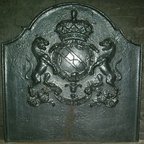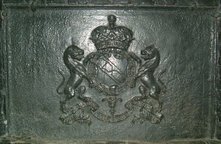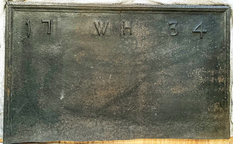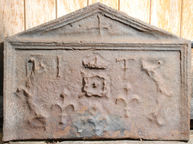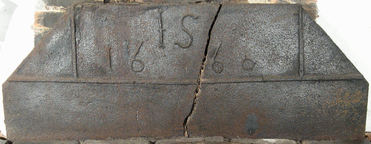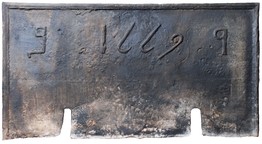-
687
Description: Rectangular with arched rectangular shaped top joined by cavetto curves; astragal edging; shield, supporters, ducal coronet, motto and garter of the Duke of Dorset: Quarterly, Or and gules, a bend vair.
Notes: Almost certainly the arms of Lionel Sackville KG (1688-1765), created first duke of Dorset in 1720.
Copies of this fireback are known.
Inscription: [around shield] HONY SOIT QUI MAL Y PENSE / [on motto scroll] AUT NUNQUAM TENTES, AUT PERFICE
Arms: Lionel Sackville, 1st Duke of Dorset
- Decoration tags:
- rectangular with canted top corners and round arch (shape)
- astragal (edging)
- carved pattern panels
- armorial
- text
Manufactured: in the early-18th century in the Weald area of England.
Current location: Knole, Sevenoaks, Kent, England.
Museum number: NT/KNO/M/41 (part of the National Trust museum group)
- Attached to series:
- Dorset arms series
- Sackville firebacks
- Personal armorial firebacks
-
688
Description: Rectangular; astragal edging; in centre, shield, supporters, ducal coronet, motto and garter of the Duke of Dorset: Quarterly, Or and gules, a bend vair.
Notes: Almost certainly the arms of Lionel Sackville KG (1688-1765), created first duke of Dorset in 1720.
Inscription: [around shield] HONY SOIT QUI MAL Y PENSE / [on motto scroll] AUT NUNQUAM TENTES, AUT PERFICE
Arms: Lionel Sackville, 1st Duke of Dorset
- Decoration tags:
- rectangular (shape)
- astragal (edging)
- carved pattern panels
- armorial
- text
Manufactured: in the early-18th century in the Weald area of England.
Current location: Knole, Sevenoaks, Kent, England.
(part of the National Trust museum group)
- Attached to series:
- Dorset arms series
- Sackville firebacks
- Personal armorial firebacks
-
1236
Description: Rectangular; ogee moulding on top and side edges; symmetrical layout of date and initials; date split between left and right sides, initials in middle.
Notes: One of a series of backs dating to the 1730s and 40s using very similar sets of letters and numerals. Formerly at Yeomans, Mayfield, Sussex.
Inscription: 17 / WH / 34
- Decoration tags:
- rectangular (shape)
- cyma reversa/ogee (edging)
- carved stamps
- individual letters
- individual numbers
- text
Manufactured: in 1734 in the Weald area of England.
Current location: not known.
- Attached to series:
- 1730s-40s, date & initial series
-
998
 pl 66 brede place a.jpg) ? x ? mm
? x ? mmDescription: Arched rectangular shape; fillet edging with a wider fillet within upon which are regularly-spaced beads each set on disc and joined by a thin line; shield, Garter, helm, mantling, crown and lion crest, with crowned lion and unicorn supporters; metal strapping around main rectangle.
Notes: A damaged example with unusual supporting bands. Formerly at Brede Place, East Sussex.
Inscription: HONI SOIT QVI MAL Y PENSE
Arms: English Stuart royal
- Decoration tags:
- rectangular with round arch (shape)
- fillet (edging)
- whole carved pattern
- armorial
- royal
- text
Manufactured: in the early- to mid-17th century possibly in the Weald area of England.
Current location: not known.
Citation: Shuffrey, L. A., 1912, The English Fireplace, London, Batsford.
- Attached to series:
- Stuart royal armorial firebacks
-
1285
Description: Rectangular; ovolo-moulded, gadrooned edging (top and sides); lower centre, a vertical spindle between two vertical spindles of a different form each surmounted by a fleur-de-lys; the date split by the top of the middle spindle; the initials above the first two and last two figures of the date.
Notes: The gadrooned style of edging is a distinctive feature of this group of firebacks, the style of fleur-de-lys being observed on two other backs within the group.
Inscription: I B / 1 6 5 0
- Decoration tags:
- rectangular (shape)
- gadrooned (edging)
- simple stamps
- carved stamps
- individual letters
- individual numbers
- heraldic
- text
- objects
Manufactured: in 1650 possibly at Cuckfield Furnace in the Weald area of England.
Current location: in private hands, Waltham St Lawrence, Berkshire, England.
- Attached to series:
- Spindle series
- Spindle/distaff firebacks
- Fleur-de-lys firebacks
-
919
Description: Arched rectangular shape; rope edging (top and sides); undulating floriate design across top of rectangle, below which are alternating roses (4) and ?crowned cross stamps (5); the same cross and rose stamps decorate the arch, three crosses on each side of a rose at the top; at the base of the arch is a row of four stamps formed of a double figure-of-eight joined by opposed concave curves; the same stamps (3), rotated 90 degrees, are arranged in a row down the left side of the plate.
Notes: Similar undulating floriate designs have been seen on late-medieval and sixteenth century stools, suggesting a possible source. A fireback with the same loop stamps bears the same date using the same numerals but impressed in reverse. Unusually, the decoration down the left side is not repeated down the right side.
Inscription: 1594
- Decoration tags:
- rectangular with round arch (shape)
- rope (edging)
- simple stamps
- carved stamps
- individual numbers
- text
- plants
- objects
Manufactured: in 1594 in the Weald area of England.
Current location: Weald and Downland Living Museum, Singleton, West Sussex, England.
(part of the Weald and Downland Living Museum museum group)
- Attached to series:
- Loop stamp (early) series
- Furniture stamp firebacks
-
689
Description: Rectangular with pediment; ovolo moulded edging inside top of pediment and inside top and sides of rectangle; centre top, four-petal rose and crown with three fleurs-de-lys below; at either end, stamps made from two parts of a wreath (the middle section missing); in the pediment a cross.
Notes: The wreaths from which the stamps have been disassembled can be seen complete on two other firebacks, and the rose and crown is a common stamp on a large series of early firebacks.
Inscription: I T
- Decoration tags:
- triangular arched (shape)
- cavetto (edging)
- carved stamps
- individual letters
- heraldic
- royal
- text
- objects
Manufactured: in the late-16th century in the Weald area of England.
Current location: in private hands, Slaugham, West Sussex, England.
- Attached to series:
- Royal series
- Royal (wreath) series
- Fleur-de-lys firebacks
-
1094
Description: Rectangular; twisted rope edging (top and sides); top centre, crowned Tudor royal shield between a lion passant on the right and a lion passant guardant sinister on the left; in each top corner a crowned four-petal rose, below which, to the right, a left-facing 'imp' with both arms lowered; below the armorial, a crowned shield bearing initials, KH, in Lombardic lettering, above a fleur-de-lys; a much-corroded imp figure may be below the right-hand lion.
Notes: A heavily corroded variant of a type bearing Henrician heraldic elements.
Arms: Tudor royal arms of England
- Decoration tags:
- rectangular (shape)
- rope (edging)
- carved stamps
- heraldic
- armorial
- animals
- humans
Manufactured: in the mid-16th century in the Weald area of England.
Current location: Smallhythe Place, Small Hythe Road, Tenterden, Kent, England.
Museum number: 1117950 (part of the National Trust museum group)
- Attached to series:
- Royal series
-
690
Description: Canted rectangle; plain edges; broad horizontal fillet dividing the plate in two just above the side angles, with vertical fillets to top corners enclosing date and initials.
Notes: Uncharacteristically crude for the period.
Inscription: IS / 16 60
- Decoration tags:
- rectangular with canted top corners (shape)
- none (edging)
- simple stamps
- individual letters
- individual numbers
- text
Manufactured: in 1660 in the Weald area of England.
Current location: Smallhythe Place, Small Hythe Road, Tenterden, Kent, England.
Museum number: 1117951 (part of the National Trust museum group)
- Attached to series:
- Date & initials firebacks
-
903
Description: Rectangular; ovolo-moulded edging (top and sides); date between split initials across upper half of plate; two notches cut away for insertion of firedogs.
Notes: The ‘6s’ appear to have been moulded from a type of jemmy.
Inscription: g 1669 P [reversed]
- Decoration tags:
- rectangular (shape)
- ovolo (edging)
- simple stamps
- carved stamps
- individual letters
- individual numbers
- text
- objects
Manufactured: in 1669 possibly in the Weald area of England.
Current location: George & Dragon Inn, Speldhurst Hill, Speldhurst, Kent, England.
- Attached to series:
- Andiron slot firebacks
- Metalware stamp firebacks
- Miscellaneous stamp firebacks
